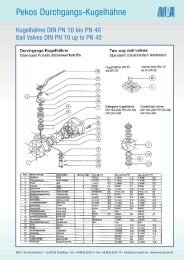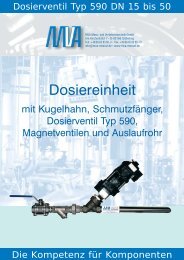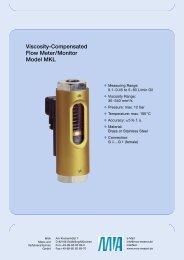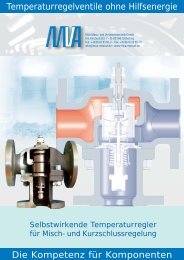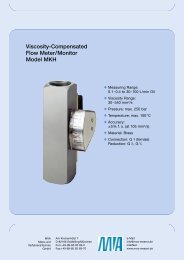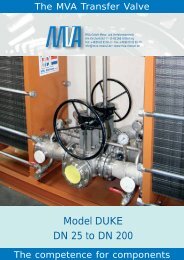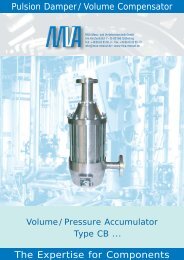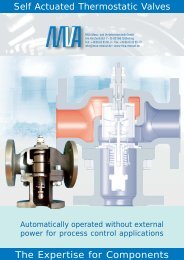Hy Supply Unit - MVA Mess
Hy Supply Unit - MVA Mess
Hy Supply Unit - MVA Mess
You also want an ePaper? Increase the reach of your titles
YUMPU automatically turns print PDFs into web optimized ePapers that Google loves.
<strong>MVA</strong><br />
<strong>Mess</strong>- und<br />
VerfahrensTechnik<br />
GmbH<br />
Am KirchenHölzl 7<br />
D-82166 Gräfelfing/München<br />
Fon +49-89-8583 69-0<br />
Fax +49-89-8583 69-70<br />
<strong>MVA</strong> - OIL HYDRAULIC SUPPLY UNIT<br />
Seite 3 von 12 C:\Eigene<br />
Dateien\Texte\Manuals\HYmanu\VBHengl1105.doc<br />
eMail<br />
info@mva-messvt.de<br />
interNet<br />
www.mva-messvt.de<br />
1. SUPPLY CONCEPT: The most simply - built valve actuators are hydraulic jacks. With suitablyselected oil<br />
pressures, they can be kept small and cheap, while delivering large forces and high power. In most<br />
applications, these actuators are mounted in groups, which are also supplied together. Group supply allows<br />
for effective and genuine redundancy with simple means.<br />
The majority of valves in a modern power plant either are not in a continuous control operation or they only<br />
make large control movements when there is a failure, which means rarely. The average power demand<br />
generally lies well below peak demand. For these operating conditions, peak demand is satisfied from an<br />
accumulator, which means that the pump is not sized to satisfy peak power demand. This lowers investment<br />
- and operating costs.<br />
While oil pressure considerably influences cost of large, powerful actuators, it is not the case for small<br />
actuators. Small supply systems requiring pumps are also for high pressure applications. This is in contrast<br />
to the last 10 to 20 years, which justify the jump to high pressure pumps in this time.<br />
2. ACCUMULATOR CHARGING: The ON/OFF operation is the charging mode with motor stoppage times<br />
of 5 to 15 minutes. A mechanical reservoir charging valve is incorporated in the small units, which switches<br />
the pump to the zero pressure cycle, but not for redundant supply units.<br />
3. POWER STEPS: A power step jump of 1.6 is appropriate and provides sufficient flexibility in the design.<br />
(A jump by the factor of 2 has proven to be too coarse.) In the following, hydraulic fluid flow in liters/minute<br />
is introduced as a type designation, followed by the nominal accumulator size (e.g. HHS2-20-30).<br />
4. ACCUMULATOR SIZES: Long - life bubble accumulators are proven in operation, as are diaphragm<br />
accumulators for smaller volumes. Accumulator size is determined by the ratio of peak power to average<br />
power, but it can also be influenced by safety considerations. The charging ratio is usually selected to be 1.2<br />
.... 1.4.<br />
5. PRESSURE CONTROL FOR THE SYSTEM SUPPLIED: Pressure control prevents deviations of the<br />
drive's running speed to get too large. When the accumulator /charging ratio is 1.2 ... 1.4, pressure control<br />
is not used, because pressure induced speed deviations remain within +/- 5 % ... +/10 %. <strong>Unit</strong>s for power<br />
plants are therefore delivered without pressure control.<br />
6. SIZING THE CONTAINER: The container volume (gross tank volume) is comprised of the minimum oil<br />
volume, the floating volume (out of reservoir and pipe) as well as the air volume (or the volume of installed<br />
equipment, respectively). Container size is therefore, to some extent, determined by the presence of a<br />
reservoir. It is sized economically (= small), it offers sufficient cooling area, provides enough oil capacity and<br />
ensures a long service life without oil changes.<br />
7. SELECTING PUMP TYPES: Long - duration laboratory tests of different types of pumps in the typical<br />
operating modes of such hydraulic units showed that, in the pressure region from 100 - 200 bar, aside from<br />
piston pumps (axial or radial), only certain heavy duty gear pumps achieve a service life which is acceptable<br />
in power plants. This good gear pumps are employed for power plants in the last 10 years up to 250 bar.<br />
8. MOTORS TYPES AND SIZES: control systens are running Motors for pump systems with reservoir<br />
charging have the following operational characteristics: they never start at full load, normally at half or 3/4<br />
load. Power demand increases continuously until switch - off or load relief in the idle mode. Heat stress is<br />
much smaller than at rated power of the motor. No masses have to be accelerated. Overloading of the motor<br />
occurs only when the charger fails at high pressure. In this case, the motor is switched off by its own<br />
protection. If it is oversized in terms of power, it will not do that. Such motors are designed with narrow<br />
margins, which lowers heat stress during start - up (as well as cost).The motors, generally four - poled three<br />
phase motors, are of the closed design, with exterior blower, protection type DIN 40050 - IP54, insulation<br />
class F (or equivalent).




